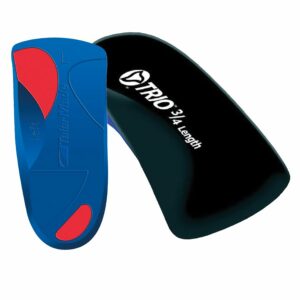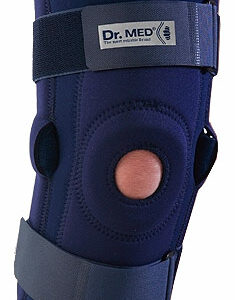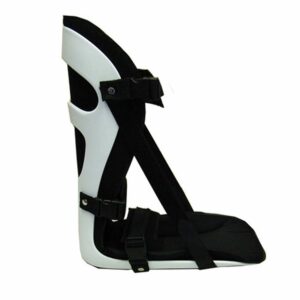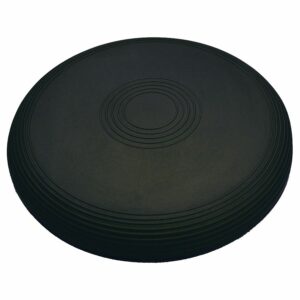Diagnostic Guide – Foot Pain
Updated:
Patients suffering from foot pain are often seen in physiotherapy practice. Pain may be caused by local structures within or around the foot or may be referred from other sources (such as the lower back).
One of the most common clinical presentations is the patient suffering from gradual onset heel pain (located under the heel) due to repetitive stress on the connective tissue attaching to the heel bone (plantar fascia – figure 1) during excessive weight bearing activity such as prolonged walking or jogging. This typically causes gradual degeneration and inflammation of the plantar fascia where it attaches to the heel bone and is known as Plantar Fasciitis. There are numerous other causes of foot pain, some of which present suddenly due to a specific incident, others which develop gradually over time.
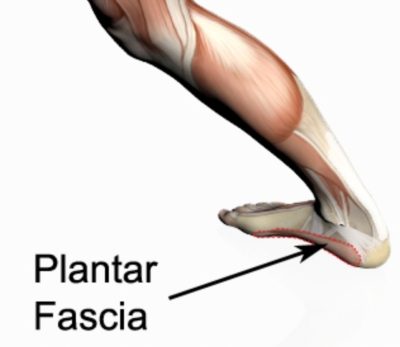
Below are some of the more common causes of foot pain with a brief description of each condition to aid diagnosis. Conditions have been organised according to sudden or gradual onset and common or less common conditions for ease of use.
Find out what may be causing your foot pain:
Sudden Onset Foot Pain – Common Injuries
Sprained Foot
Tearing of connective tissue holding the bones of the foot together (figure 2) typically following a fall or twisted foot. Associated with pain on firmly touching the affected joint and often swelling.
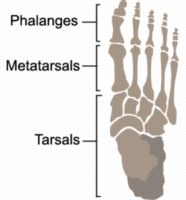
Fat Pad Contusion
Bruising of the fat pad located under the heel bone (calcaneus – figure 3) usually due to a fall onto the heels from a height. Associated with pain on weight bearing through the heel bone and on firmly touching the affected region.
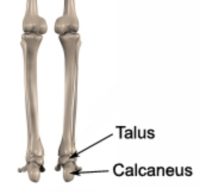
Plantar Fascia Strain
Tearing of the connective tissue forming the arch of the foot usually where it attaches to the heel bone (Plantar Fascia – Figure 1). Associated with pain or ache under the heel and into the inner sole of the foot and tenderness on firmly touching the plantar fascia.
Sprained Toe
Tearing of connective tissue holding the bones of the toe together (figure 4) typically following excessive bending of the joint. Associated with pain on firmly touching the affected joint and often swelling.
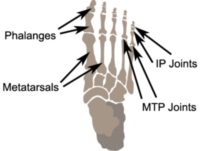
Subungual Hematoma
Pain arising from bleeding under the toenails usually due to direct trauma or repetitive pressure from footwear.
5th Metatarsal Fracture
Fracture of the 5th metatarsal bone of the foot (figure 5) usually due to traumatic forces such as a rolled ankle. Associated with severe foot pain, swelling and tenderness on firmly touching the affected region of the bone.
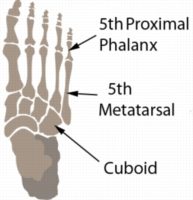
Referred Foot Pain
Pain referred into the foot from another source such as the lower back, frequently associated with symptoms above the foot (such as the buttock, thigh or lower leg) and in the referring area (e.g. lower back pain / stiffness). Typically associated with tenderness on firmly touching the region responsible for the referred pain and / or loss of movement in that region. Sometimes in association with pins and needles or numbness.
Less Common Sudden Onset Injuries
Calcaneus Fracture
Fracture of the heel bone of the foot (calcaneus – figure 3) usually due to traumatic weight bearing forces such as landing on the heel from a height. Associated with severe foot pain, swelling and tenderness on firmly touching the affected region of the bone.
Cuboid Syndrome
Partial dislocation of the cuboid bone located at the outer aspect of the mid foot (figure 5) typically following a rolled ankle or due to repetitive forces. Symptoms typically include pain or ache in the outer aspect of the mid foot or ankle and pain on firmly touching the affected bone.
Tarsal Tunnel Syndrome
Entrapment of the nerve located at the inner aspect of the ankle causing pain radiating into the arch of the foot, heel and occasionally toes. Often associated with pins and needles or numbness and tenderness on firmly touching the tarsal tunnel region (figure 6).
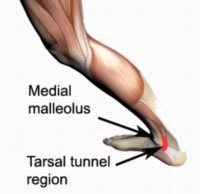
Gradual Onset Foot Pain – Common Injuries

Members Only ContentBecome a PhysioAdvisor Member to gain full access to this exclusive content. For more details see Become a Member. Already a member? Login Now
Less Common Gradual Onset Injuries

Members Only ContentBecome a PhysioAdvisor Member to gain full access to this exclusive content. For more details see Become a Member. Already a member? Login Now
Diagnosis of foot pain
A thorough subjective and objective examination from a physiotherapist is usually sufficient to diagnose the cause of foot pain. Investigations such as an X-ray, ultrasound, MRI, CT scan or nerve conduction studies are often required to confirm diagnosis and rule out other injuries.
Find a Physio
Find a physiotherapist in your local area who can diagnose and treat patients suffering from foot pain.
More Information.
- View Ankle Stretches.
- View Ankle Strengthening Exercises.
- View Balance Exercises.
- View detailed information on initial injury management and the R.I.C.E Regime.
- View detailed information on when to use Ice or Heat?.
- View detailed information on How to use Crutches.
- View detailed information on Do I Need Orthotics?.
Physiotherapy products for foot pain
Some of the most commonly recommended products by physiotherapist for patients with foot injuries include:
To purchase physiotherapy products to assist with rehabilitation click on one of the above links or visit the PhysioAdvisor Shop.

Link to this Page
If you would like to link to this article on your website, simply copy the code below and add it to your page:
<a href="https://physioadvisor.com.au/injuries/foot”>Diagnostic Guide – Foot Pain – PhysioAdvisor.com</a><br/>PhysioAdvisor provides a diagnostic guide for patients suffering from foot pain created by experienced physiotherapists. Find out about foot pain causes.
Return to the top of Diagnostic Guide – Foot Pain.

